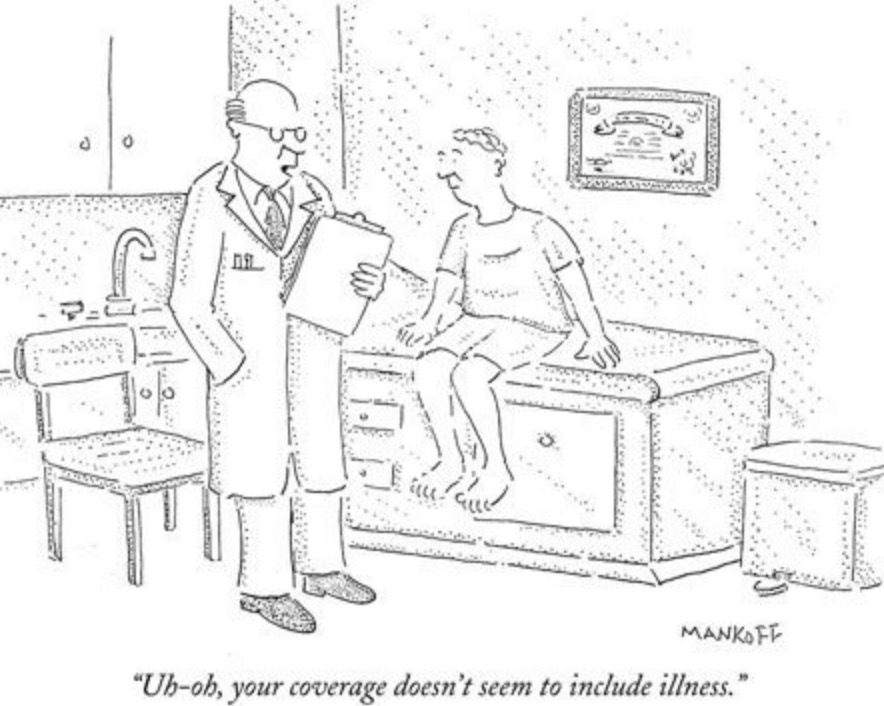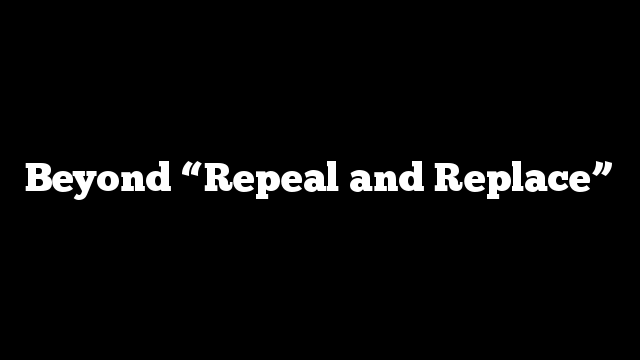
The toxic polarization of Washington politics might lead even the most stubborn optimist to abandon any hope for bipartisanship on healthcare. Despite endemic pessimism, the flagging efforts to forge a Republican consensus on “repeal and replace” might set the stage for overdue efforts at compromise. Congress will be tempted to move on to more promising areas such as tax reform and infrastructure funding. That temptation should be resisted. The threat to the nation posed by the current state of American healthcare calls for Congress to resurrect the long lost spirit of bold bipartisanship.
Before considering opportunities for compromise, the obstacles confronting the GOP reform efforts are worth considering. Republicans face the same stubborn reality that confronted the framers of the Affordable Care Act (ACA): Expensive services cannot be covered by cheap insurance. The cost of U.S. healthcare has simply priced low income and even middle income individuals out of health insurance. Without subsides, they get left behind. The Congressional Budget Office’s estimated that the Ryan plan would result in 24 million losing coverage underscored the political divide: Confronted with unmanageable healthcare costs, most Republicans would opt to reduce public expense whereas Democrats plus a handful of Republican moderates prefer more extensive coverage. The effort of the GOP leadership to split the difference by preserving some residual subsidies and the structures supporting them—“Obamacare light”—remains unacceptable to many on the right. No clear middle ground has yet emerged.
The healthcare cost quandary affects far more Americans than the 3% of the public currently covered through the ACA exchanges or those covered through the Medicaid expansion. We spend about 17% of GDP on healthcare, or about 7% more than the average developed country. That 7% translates into $1.3 trillion in excessive expense, or about 2.5 times the U. S. military budget. Health outcomes data suggest that we derive no significant benefit from that mountain of wasted resources. Meanwhile, the staggering burden of healthcare cost squeezes employers and makes U.S. industry less internationally competitive. It displaces investment and infrastructure spending. It contributes to U. S. dependency on foreign bond holders to fund the government deficit. In short, U.S healthcare bloat poses nothing short of an existential threat to our economic well-being and our national security. In looking beyond the ACA, we need to consider the costs of the entire system including Medicare and commercial health insurance.
Americans are either seniors now or seniors of the future so we should all be concerned about Medicare. Although its payment system is efficient, Medicare must buy healthcare services in the same overpriced market as the commercial plans. The program’s expenses now account for about 14% of the Federal Budget and will increase by an estimated 60% over the next decade. The Part A trust fund, which pays for hospital expenses, is projected to go broke by about 2030. Republicans have proposed reducing Medicare expense via a voucher program to cap costs. Democrats reject such a program due to concerns that inflation would erode the voucher’s value, allowing low income seniors to be priced out of healthcare.
Democrats and Republicans both complain about the high cost of the commercial health insurance sold to employers and individuals. Democrats focus on the 15-20% overhead devoted to corporate expenses like advertising, executive salaries and shareholder profit, rather than to care. In contrast to the commercial plans, Medicare’s overhead, absent these costs, runs in the 3-4% range. Allowing access to a Medicare option for younger individuals and employees would allow billions of dollars of commercial insurance overhead to be directed toward productive care. Republicans generally oppose a Medicare option for the public due to their concern that it would increase the government’s role in healthcare.
A healthcare compromise, giving Democrats a Medicare option for employers and exchanges in return for a Republican inspired voucher system for Medicare, could offer a pathway to practical cost savings if the legitimate concerns of both sides were adequately addressed. For Democrats, protection for seniors’ healthcare access in a Medicare voucher system could be achieved by providing a floor to the value of the voucher to serve as a safety net. One possible means of preserving the voucher’s value would be to peg it to the price of Medicare Advantage programs in specific regions. Under Medicare Advantage, the federal government pays a fixed amount per beneficiary to a private insurer. The insurer then accepts responsibility to provide all necessary services for that price. With effective cost management, these plans are efficient enough to provide seniors with full coverage without paying for a part B “Medicap” plan to cover the program’s 20% copayments, nor additional fees for a part D Drug program. The attraction of these cost savings for seniors has allowed Medicare Advantage to triple its senior population over the last decade. The program now provides care for over 30% of the nation’s seniors. A voucher system pegged to the cost of Medicare Advantage has the potential to reduce costs while continuing to guarantee seniors access to full coverage. Not only would such a system conserve resources, but recent evidence suggest that Medicare Advantage can improve outcomes and even save lives when compared to traditional fee-for-service Medicare.
The same Medicare options offered to seniors under a voucher plan could be provided to employers and the insurance exchanges as the Medicare Option. Republican could be reassured that the program would limit the government’s involvement in healthcare, as Medicare Advantage programs are administered by private insurers. The care under the Medicare Advantage and other Medicare options would continue to be provided by physicians in community based private practices, not by the government.
Offering Medicare Advantage and other Medicare plans along with the current array of private insurance offerings would enhance competition in the commercial insurance marketplace. If private commercial plans offered better care or more cost effective care, individuals would be free to choose them. When individuals choosing the Medicare Option reached retirement, they could simply keep their same Medicare plan, with government funding replacing the funding provided by their employer. No longer would retirement mean a different plan and possibly different providers. Finally, allowing Medicare Advantage plans to compete in the commercial insurance market would speed the growth of these plans and provide the economies of scale needed to improve the quality of their networks. Areas of the country that lack efficient managed care systems would likely see increased development of systems that could save money for both employers and the public while providing better care.
The opportunity to achieve savings, improve healthcare choices, enhance competition and improve the financial security for Medicare should attract support from a broad spectrum of Americans and from the political leaders of both parties. Nevertheless, achieving large scale compromise would not happen easily. The insurance companies, pharmaceutical companies and others that profit from the inefficiencies of the current system can be expected to feed partisan antagonisms and fight to protect their stake in the status quo.
In the competitive global economy of the 21st Century, Americans can no longer afford to pay what amounts to $1.3 billion dollar healthcare tax that yields no demonstrable benefit. The public needs to wake up and pressure the political the leadership to direct their attention away from electoral politics and special interest advocacy and start working toward bipartisan, creative solutions to address healthcare costs. A trade-off of Medicare Vouchers in return for increased public access to Medicare options offers one possible direction. The national interest demands that Congress and the President begin work on meaningful bipartisan action before it’s too late.
Daniel Stone is a practicing geriatrician in Los Angeles.
